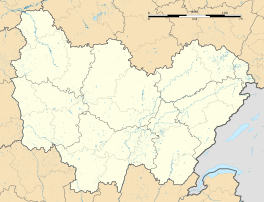Dole, Jura
| Dole | ||
|---|---|---|
|
Old Dole | ||
| ||
 Dole | ||
|
Location within Bourgogne-Franche-Comté region  Dole | ||
| Coordinates: 47°05′35″N 5°29′26″E / 47.0931°N 5.4906°ECoordinates: 47°05′35″N 5°29′26″E / 47.0931°N 5.4906°E | ||
| Country | France | |
| Region | Bourgogne-Franche-Comté | |
| Department | Jura | |
| Arrondissement | Dole | |
| Government | ||
| • Mayor (2014–2020) | Jean-Maris Sermier (UMP) | |
| Area1 | 38.38 km2 (14.82 sq mi) | |
| Population (2008)2 | 25,384 | |
| • Density | 660/km2 (1,700/sq mi) | |
| Time zone | CET (UTC+1) | |
| • Summer (DST) | CEST (UTC+2) | |
| INSEE/Postal code | 39198 / 39100 | |
| Elevation | 196–341 m (643–1,119 ft) | |
| Website | www.Dole.org | |
|
1 French Land Register data, which excludes lakes, ponds, glaciers > 1 km² (0.386 sq mi or 247 acres) and river estuaries. 2 Population without double counting: residents of multiple communes (e.g., students and military personnel) only counted once. | ||
Dole (French: [dɔl],[1] sometimes wrongly pronounced [dol],[2] probably due to the incorrect orthography "Dôle" sometimes encountered) is a commune in the Jura department in the Franche-Comté region in eastern France, of which it is a subprefecture (sous-préfecture).
History
Dole was the capital of Franche-Comté until Louis XIV conquered the region; he shifted the parlement from Dole to Besançon. The university, founded by Duke Philippe le Bon of Burgundy in 1422, was also transferred to Besançon at that time.
In January 1573, Gilles Garnier was put to death after being found guilty of lycanthropy and witchcraft. He had confessed of murdering and cannibalizing four young children.
The 1995 film, Happiness Is in the Field, was set in Dole.
Geography
Dole is located on the Doubs River. The commune has a land area of 38.38 km2 (14.82 sq mi).
Population
| Historical population | ||
|---|---|---|
| Year | Pop. | ±% |
| 1793 | 9,000 | — |
| 1800 | 8,235 | −8.5% |
| 1806 | 8,678 | +5.4% |
| 1821 | 9,647 | +11.2% |
| 1831 | 9,927 | +2.9% |
| 1836 | 10,137 | +2.1% |
| 1841 | 10,713 | +5.7% |
| 1846 | 10,519 | −1.8% |
| 1851 | 10,830 | +3.0% |
| 1856 | 10,985 | +1.4% |
| 1861 | 10,605 | −3.5% |
| 1866 | 11,093 | +4.6% |
| 1872 | 11,679 | +5.3% |
| 1876 | 12,924 | +10.7% |
| 1881 | 13,190 | +2.1% |
| 1886 | 13,293 | +0.8% |
| 1891 | 14,253 | +7.2% |
| 1896 | 14,437 | +1.3% |
| 1901 | 14,627 | +1.3% |
| 1906 | 14,838 | +1.4% |
| 1911 | 16,294 | +9.8% |
| 1921 | 16,208 | −0.5% |
| 1926 | 18,093 | +11.6% |
| 1931 | 18,066 | −0.1% |
| 1936 | 18,117 | +0.3% |
| 1946 | 18,250 | +0.7% |
| 1954 | 22,022 | +20.7% |
| 1962 | 24,525 | +11.4% |
| 1968 | 27,188 | +10.9% |
| 1975 | 29,295 | +7.7% |
| 1982 | 26,889 | −8.2% |
| 1990 | 26,577 | −1.2% |
| 1999 | 24,949 | −6.1% |
| 2008 | 25,384 | +1.7% |
It is the largest commune in Jura, although the préfecture is Lons-le-Saunier.
Transport
Dole – Jura Airport is located in the commune of Tavaux, 7 km southwest of Dole.
Famous residents
- Simon Bernard (28 April 1779 – 5 November 1839)- Napoleonic aide de camp and notable engineer in the United States.
- Marie Émile Antoine Béthouart (17 December 1889 – 17 October 1982), soldier.
- Louis Pasteur (December 27, 1822 – September 28, 1895), microbiologist and chemist
- Suzanne Douvillier, pioneer dancer and choreographer, born in Dole
- Hubert-Félix Thiéfaine (July 21, 1948 − ), pop-rock singer and songwriter, born in Dole
- Michel Chapuis (1930- ), organist
- Flavien Larderet (February 3, 1983 − ), singer, songwriter and composer, born in Dole
Museums
The Museum of Fine Arts, Dole founded in 1821, is located in the House of the Officers, an example of military architecture of Franche-Comté at the 18th century.
Twin towns
Dole is sister city to the following cities in four countries:
-
 Lahr, Baden-Württemberg, Germany since 1962
Lahr, Baden-Württemberg, Germany since 1962 -
 Northwich, Cheshire, England
Northwich, Cheshire, England -
 Tábor, Czech Republic
Tábor, Czech Republic -
 Carlow, Ireland
Carlow, Ireland
See also
References
- ↑ (French) Henri Bertand in the video Henri Bertand se livre, tvdole.com
- ↑ (French) Francis Guthleben in Imagine ce pays - Dôle, France 3 Bourgogne-Franche Comté
External links
| Wikimedia Commons has media related to Dole, Jura. |
- Official website (in French)
Dole Basilica:

.svg.png)